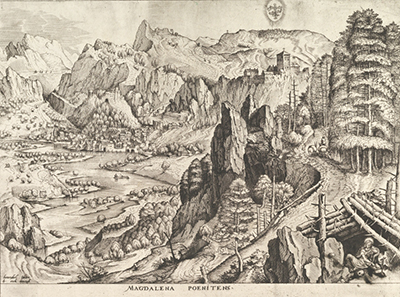The Penitent Magdalene provides a sweeping North European landscape that focuses on the beauty of this region but is devoid of colour because of its nature as a published print from an earlier engraving. Bruegel the Younger would later take some of his father's work and reconstitute it for his own needs.
Within this composition we find a pathway leading through the right hand side of a rockface, surrounded by rows of trees on one side and pointed rocks on the other. In the nearest foreground is a collection of collected logs and a few human figures who are connected to the main theme of the piece. In the far distance we find a wide valley with a river which winds its way down to the bottom. There are also many mountains in the background, covering most of that part of the painting, and leaving just a small gap for the sky above. There is a good variety within The Penitent Magdalene, from awe inspiring mountains down to tiny human figures and small shrubs, reminding us of how this artist would go into incredible detail each and every time.
It seems extraordinary that such detailed artworks such as this could then be turned into identical engravings, featuring multiple levels of etched content. It is a credit to those who helped Bruegel in the later stage that this would even be possible, but it must be remembered that Northern Europe was particularly rich in engravers of a high standard during the 16th century and so these technical challenges would be entirely possible. Once complete, each engraving would be handed over to Hieronymus Coch in Antwerp for the final stage of the process, where prints would be produced and artworks were then ready to be sold and distributed across the country and abroad. He worked for a number of different clients and became known as one of the most famous printmakers in Europe at that time.
Mary Magdalene has, of course, been featured by countless numbers of artists over the years. She was seen the most during the Renaissance, at it swept across Europe in the 15th and 16th centuries, gaining inspiration from artists both in Italy as well as in Northern regions such as the Flemish painters and engravers. Those looking to understand this theme in greater detail should study related works such as The Entombment by Michelangelo, Penitent Magdalene by Titian in both 1531 and 1565 and also Mary Magdalene by Artemisia Gentileschi. The latter was a female artist who has started to receive greater recognition in recent years, with liberal art followers seeking to redress the balance of exposure, as they see it.




